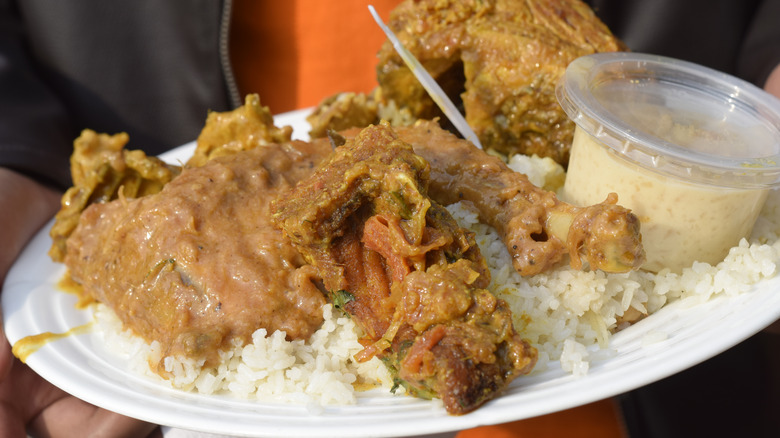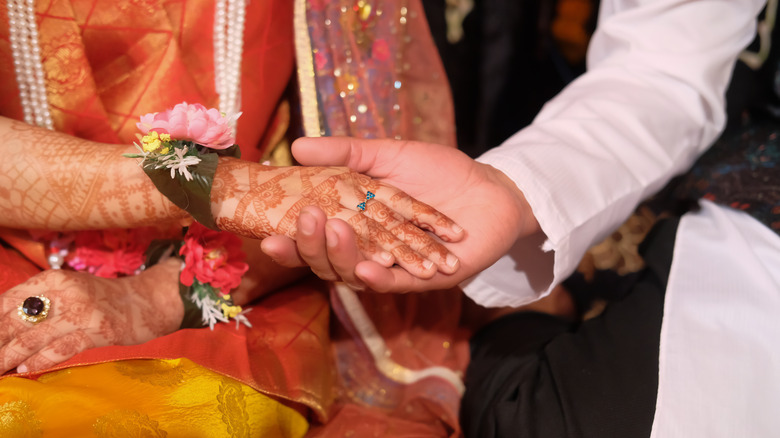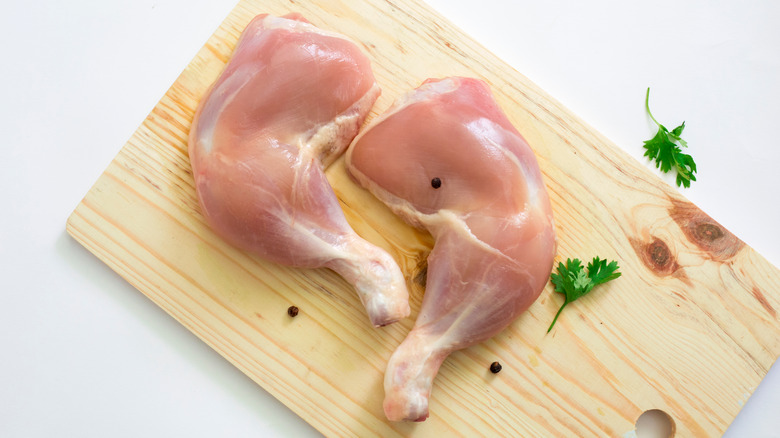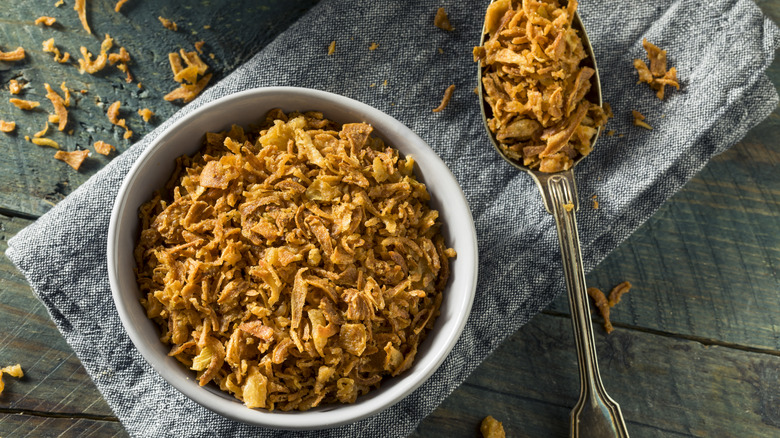Bangladeshi Wedding Roast Chicken Is Not Exactly What You May Expect
Traditional Bangladeshi food is a rich and culturally-diverse cuisine that showcases a deep history embedded into each dish. Delicious Bangladeshi foods are stacked with a variety of flavors, from curries like chingri malai curry to robust fish-based meals to sweet desserts reserved for Ramadan, such as falooda. The nation's favorite foods have all been influenced by neighboring countries, British rule, and the prominence of the Muslim faith, and each dish holds its own traditional place on Bangladeshi tables.
There's no dish more common at celebratory tables in the country than Bangladeshi wedding roast chicken, also known as biye barir murgi roast. This juicy chicken dish is bathed in a deeply-seasoned, rich sauce that balances savory and sweet flavors together. Paired with crispy onions and rice, these ingredients add a crunchy texture to this otherwise luxuriously-creamy meal. Just like the name suggests, this dish has a place at nearly every Bangladeshi wedding; however, it provides much more to the culture than making an appearance on these special days.
History of Bangladeshi wedding roast chicken
According to Epicurious, who cites chef and scholar Sanhita Dasgupta Sensarma, it's likely that this beloved dish has old, ancient origins. The first variation of this meal was known as murgh musallam, which came from "Turko-Persian-Afghan Mughal influence." Traditionally, instead of using the now-popular chicken quarters, a whole bird was prepared instead. This was possibly done by the royal Sultan's army rule to ensure the military men shared their meals with each other, encouraging bonding between the individuals. This practice has largely fallen away, except at weddings where the bride and groom are still served a whole bird to share, as Dasgupta Sensarma shares.
As for the celebratory occasions, the name can be a bit deceptive. This chicken recipe is a staple at Bangladeshi weddings, enjoyed among the biryani, samosas, and kebabs. However, while it's destined to make an appearance at these sacred ceremonies, it also has a designated place at the table for other important Bangladeshi celebrations. From Eid to simple birthday parties, this roast chicken has a special hold on Bangladeshi culture. But, while preparation styles for this dish have changed over the centuries, the ingredient list has stayed relatively consistent.
Ingredients in Bangladeshi wedding roast chicken
Depending on which recipe you follow, there will likely be many variations when it comes to spices and ingredients. For example, when it comes to seasoning the chicken quarters, only two ingredients are needed: salt and a yellow spice, like turmeric or chili powder. However, yogurt-based marinades infused with ginger and garlic paste, salt, pepper, and other whole and pureed spices are also often used to tenderize the meat.
The same variation is true for the thick gravy that accompanies this juicy chicken. A typical lineup for the sauce includes several aromatics like cinnamon, cardamom, cloves, mace, bay leaves, garlic, ginger, coriander, poppyseed, cumin, along with nut purees (typically cashew), and much more. The sauce is thinned out with water, sometimes rose or kewra water, for extra floral notes. Fried onions are a common topping for this dish, and the chicken, sauce, and onions are all cooked in ghee, a clarified butter prevalent in South Asian cooking.
While this may seem like an ingredient list uncommon for a traditional roast chicken, you'd be right. That's because this chicken isn't actually roasted at all but made on a stove utilizing another cooking method with a frying pan or wok.
How Bangladeshi wedding roast chicken is made and eaten
Rather than using a high-temperature oven to cook, this chicken instead uses a stove-top technique popular in South Asian cooking known as bhuna, which refers to frying or sautéing your meat with a thick sauce. The first step is to scour or puncture the chicken, which helps the flavors to penetrate deeper into the meat throughout the cooking process. Then, rubbing the chicken with salt and a yellow-dying spice is done. However, as noted previously, this is where recipes can opt to marinate the chicken for several hours in a spice-infused yogurt as well.
The chicken is then put aside as onions are then fried in ghee. Once crispy, the onions are removed, and the seasoned chicken is added to the pan. When the meat has cooked through, and the skin is golden, it can be removed. Some aromatics such as cinnamon, cardamom, cloves, and bay leaf then get fried in hot oil, and the pre-mixed masala paste is added to form the sauce along with some water. Once this is adequately cooked and creamy, the chicken gets placed back in.
The final result is a bubbling-hot, saucy chicken dish completed by topping with crispy onions, occasionally sliced almonds, and alongside a bed of pilau rice. And, while you may not be planning on serving this as a starter course at your own wedding, it may be the perfect addition for a crowd-pleasing weeknight dinner or celebratory birthday meal.



